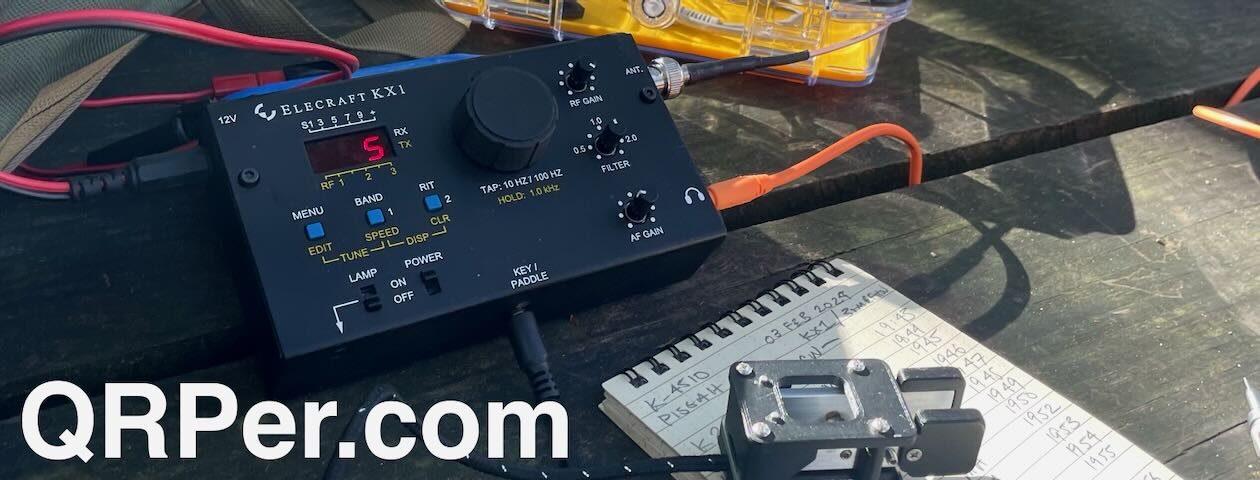 On January 26, 2022, I fit in multiple park activations in one day as a RaDAR (Rapid Deployment Amateur Radio) run. My hope was to activate four or five sites between 14:00 – 21:30 UTC.
On January 26, 2022, I fit in multiple park activations in one day as a RaDAR (Rapid Deployment Amateur Radio) run. My hope was to activate four or five sites between 14:00 – 21:30 UTC.
Here are the field reports and videos of my first three activations:
- #1 Lake James State Park (K-2739) using the Xiegu X5105 and Speaker Wire antenna
- #2 Pisgah National Forest & Game Land (K-4510/K-6937) using the Elecraft KX2 and PackTenna linked 40M EFHW
- #3 Table Rock Fish Hatchery (K-8012) using the Yaesu FT-817 and PackTenna 9:1 UNUN Random Wire
The next park in my run (#4) was either going to be my last activation, or second to last depending on my available time.
After visiting with my buddy, Hamilton, at his ceramics studio in Morganton (read about that in the previous report) I looked at the time and decided I could fit in a very quick activation of Johns River Game Land (#4) en route to Tuttle Educational State Forest (#5).
I made up my mind en route that I’d use my fastest-to-deploy combo: the Elecraft KX2 and Chameleon CHA MPAS Lite.
I really wanted to be in and out of the site within a 20 minute window. That’s actually very doable as long as I could rack up at least ten contacts in 10-15 minutes. Some days, propagation can make that a tall order, though!
Johns River Game Land (K-6916)
 Johns River actually has a number of access points and, frankly, none of them are exactly “bucolic.” Other than the river itself which is beautiful and the main access point for the river which is well-maintained, most of the game land parking areas are filled with litter.
Johns River actually has a number of access points and, frankly, none of them are exactly “bucolic.” Other than the river itself which is beautiful and the main access point for the river which is well-maintained, most of the game land parking areas are filled with litter.
I chose a parking area for this activation which has, in the past, looked like a dumping ground. I was pleased when I pulled into the parking lot this time to find it much cleaner (no old refrigerators or sofas dumped at the far end of the lot) but then again the snow on the ground was likely hiding quite a bit of litter! My philosophy is to always leave a site cleaner than I found it, but Johns River often has so much littler, I could spend a week picking up trash.
After doing a very short intro for my activation video, I set up the Elecraft KX2 and MPAS Lite antenna in a matter of two minutes.
Gear:
- Elecraft KX2 and KXPD2 Paddles
- Chameleon CHA MPAS Lite
- Rite In The Rain Weatherproof Cover/Pouch (affiliate link)
- Jovitec 2.0 mm Mechanical Pencil (affiliate link)
- Muji A6 Notepad (affiliate link)
- Camera: OSMO Action Camera (affiliate link)
On the air
 I started calling CQ POTA (with my fingers crossed!) on 40 meters and was very pleased that chasers were out and about!
I started calling CQ POTA (with my fingers crossed!) on 40 meters and was very pleased that chasers were out and about!
I worked my ten contact in 9 minutes and then went QRT! Woot! Here’s the log sheet:
In this short activation, there was actually a P2P with Max (WG4Z) who was just up the road at Tuttle Educational State Forest. We were definitely working each other via ground wave.
The contacts were flowing so well, that I wanted to stay on the air a bit longer, but I knew to fit in Tuttle and a hike, I really needed keep moving. As soon as I worked my ten, I hopped off the radio.
While I like putting more contacts in the log–especially when they’re flowing so freely–it was actually kind of fun to validate this activation in somewhat of a “sprint.”
QSO Map
Here’s what 5 watts and the MPAS Lite yielded in nine minutes on the air:
Activation video
Here’s my real-time, real-life video of the entire activation. This must be one of the shortest activation videos I’ve ever made:
Click here to view on YouTube.
Thank you
 Thank you so much for reading this short report and coming along with me on this RaDAR run! I’ll be posting Park #5–Tuttle Educational State Forest–soon where I catch up with Max (WG4Z) and we work park-to-park once again.
Thank you so much for reading this short report and coming along with me on this RaDAR run! I’ll be posting Park #5–Tuttle Educational State Forest–soon where I catch up with Max (WG4Z) and we work park-to-park once again.
As always, I’d like to send a special thanks to those of you who have been supporting the site and channel through Patreon and the Coffee Fund. While certainly not a requirement as my content will always be free, I truly appreciate the support.
These are crazy times we’re living in these days (at time of posting). I wish all of you good health, safety, and peace–especially our good friends in Ukraine.
Let’s all treat each other with kindness and respect this week as we remember that all we’ve got on this old planet is each other.
I hope you get some time to play radio this week!
72,
Thomas (K4SWL)






























